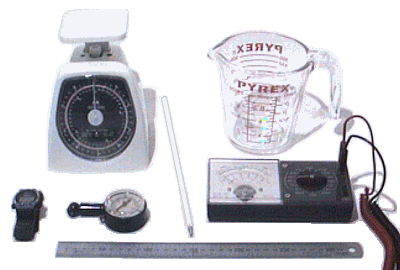Metric Units

S.I. Base Units
The International System of Units (S.I.) defines seven base units for the seven base quantities:do you want to learn complete?click here

Sumber link:
http://physics.nist.gov/cuu/Units/units.html
http://www.metricviews.org.uk/2007/06/07/british_cast_kilogram/
http://www.metrication.com/units/
ingin lengkapnya klick disini
1. satuan suhu
Satu kelvin adalah 1/273,16 suhu titik tripel air.
2. Satuan kuat arus listrik
Satu ampere adalah arus tetap yang dipertahankan untuk tetap mengalir pada dua batang penghantar sejajar dengan panjang tak terhingga dan dengan luas penampang yang dapat diabaikan dan dipisahkan sejauh satu meter dalam vakum, yang akan menghasilkan gaya sebesar 2 x 10-7 N m-1
untuk materi selengkapnya klick disini
MEASUREMENT
Basic competence
1.1 to describe fundamental quantities, derived quantities, and their units
1.2 to describe the definition of temperature and its measurement
1.3 to do basic measurement using familiar measuring tool in daily life.
untuk melihat secara lengkap klick disini...

? DEFINITION OF MEASUREMENT
In the past, people use their own units of measurement without egreeing with other people. For example:
Span : the distance between the spread of little finger and thumb
Palm width : the width of all fingers of hand.
Arm length : the between elbow and tip of middle finger
All these units are easy to get but they often make disputes. Why? To answer this do the following activities!
A. What you need
Hand and ruler
B. Procedures

C. Data observation
Table 1
| Objects measured | Measurement units | Result of measurement |
| Length of desk Length of book Width of door | Span Palm width span | ………. ………. ………. |
Table 2
| Objects measured | Measurement units | Result of measurement |
| Length of desk Length of book Width of door | cm cm cm | ………. ………. ………. |
5. Compare results of your groups’s meuserement with other groups!
D. Question and conclusion
1. Look at table 1!
Will you find diffrences in the results of your groups’s meuserement with the results from other groups? Why does this happens?
2. Look at table 2!
Will you find diffrences in the results of your groups’s meuserement using a ruler when you compare them with the results from other groups? Why does this happens?
3. What is needed to have same measerement?
4. From your activitied. Make summary, What is measurement?
LESSON PLAN
Unit : SMPN 5 Probolinggo
Grade / Term : VII / 1
Subject : SCIENCE – Physics
Topic : 1. Quantities and Their Units
Time Allocation : 40 minutes
To understand the scientific procedure for learning the natural objects using tools.
1.1. To describe fundamental and derived quantities and their units.
1. To identify the physics quantities in daily life and then to classify them in fundamental and derived quantities.
2. To use the international units in measurements.
Students are able to :
1. Identify the physics quantities in daily life and then to classify them in fundamental and derived quantities.
2. Differentiate the fundamental and derived physical quantities.
3. Mention the units of fundamental and derived physical quantities.
4. Show the derived quantity units from fundamental quantity units
5. Use the international units in measurements.
o Measuring is to compare a physical quantity of an object with similar quantity used as a unit.
o The result measurement is useful it it uses a standard measurement.
o Quantities are everything that can be measured, has value that can be expressed by number, and has the certain units.
o The physical quantity divided into: fundamental quantities and derived quantities.
1. Approach : Cooperative learning
2. Methods : Discussion, presentation.
| Phases | Activities |
| Opening (5 minutes) |
- Show to students some examples of products - Ask students to mention some physical quantities which are labeled on the products.
Can you mention physics quantities in the classroom? |
| |
|
| Closure (10 minutes) |
|
1. Student’s book
2. References
3. Student worksheets
1. Techniques : Written test , presentation
2. Instruments : Essay and scoring rubric
3. Examples of test items:
a. Written test.
Answer the questions below.
1. Explain the definition of physical quantities.
2. Physical quantities are classified into two groups those are …….
3. Explain the definition of fundamental and derived quantities.
4. Mention five fundamental quantities and their international units!
5. Area is a derived quantity. The quantity is derived from fundamental quantities of
6. Mention five derived quantities and their international units!
b. Presentations
Scoring rubric of Presentation
| No | Student’s Name | Aspects | | |||||
| Content | Perfor- mance | Answer’s Quality | Language Usage | Resource | Conclu- tion | Total Score | ||
| 1 | | | | | | | | |
| 2 | | | | | | | | |
| 3 | | | | | | | | |
| 4 | | | | | | | | |
| 5 | | | | | | | | |
Notice : Score for each aspect: 5 - 10
Acknowledged by, Teacher
School Principal
Drs. HARTONO, M.Pd Toni Gigih Pradono Ali
Nip. 19610606198112 1 005 Nip. 19730421199802 1 001